The Knights of the Star and their Giant Sacred Pentagram in France
In June of 1344, Pope Clement VI moved to reorganize the Knights of France in a series of six letters sent to Jean, Duke of Normandy, the son of King Philip VI of France. The pope proposed that the Duke of Normandy establish a congregation of so-called Knights of the Star, and as an incentive he promised to grant them extraordinary privileges.
Any knights selected by the Duke of Normandy within ten years of the date of the pope’s letter would qualify for absolution of all their sins, a privilege that was normally only reserved for members of the Holy See. The Duke of Normandy waited until his father Philip VI had died, then, newly crowned as King John II of France in 1350 (Jean II in French), he made his move and sought to take advantage of the pope’s proposal.

The founding of the order of the Knights of the Star from the 14th-century Grandes Chroniques de France, a heavily illuminated compilation of history. (Public domain)
Following the Radiant Path: The Knights of the Star
The Chronicle of Jean le Bel, written between 1351 and 1356, records this momentous event, documenting how “the King of France Jean II [John II] ordained a company of knights at the example of the Round Table, and it was called the Company of the Star.” So it was that the Royal Order of the Star was founded in St. Ouen on January 16, 1351.
The five-pointed pentagram star was the heraldic symbol John II, later known as Jean le Bon (John the Good), had chosen for his personal coat of arms. On the statutes of the Order of the Star we see a five-pointed radiating star set against a backdrop of another vertically mirrored five-pointed star.
- Greed and Decline: The Treasure of the Knights Templar and Their Downfall
- The Masonic Initiation Wells of the Quinta da Regaleira
Furthermore, the king’s personal motto included his emblem monstrant regibus astra viam, or “the star shows men the way to follow.” This motto conjures up images of the star of Bethlehem leading the magi to Christ. The full name of the Order was the “Illustrious Starbearing Knightly Congregation in the Noble House at Saint-Ouen,” or the Knights of the Star for short.
In a contemporary account, the Chronicle of the First Four Valois, composed around 1380, it is made clear that this new order bore more than a passing resemblance to the Knights Templar. For example, the members of the Knights of the Star were required to swear an oath stating that they would never flee from battle. They were ordered to dress in red and white, wearing the device of the King on their mantles; a five-pointed pentagram star.
Some knights also wore an eight-pointed star on their garments, one of the earliest known versions of what we today call the Maltese Cross. Finally, the first selected members of the Order of the Star consisted of “nine worthy knights,” just like the legendary original nine members of the Order of the Knights Templar, founded in 1119.
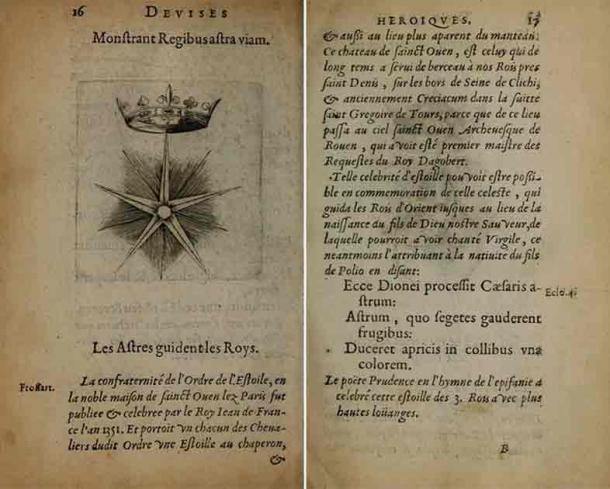
Statutes of the Order of the Star, featuring John II’s emblem. (Author provided)
Searching for the Knights of the Star at the Labyrinths of Chartres and Amiens
During the research for our book, The Jerusalem Files: The Secret Journey of the Menorah to Oak Island, we encountered a peculiar phenomenon in France. The country boasts nearly 100 cathedrals and grand churches, yet some hold a more distinct significance than others. Our curiosity was piqued during our investigation of the renowned Chartres Cathedral. We found ourselves pondering why such a colossal stone structure, an undisputed medieval masterpiece, had been erected in that specific location.
Unless you have stood in the cathedral’s hallowed spaces yourself, and witnessed first-hand how all-encompassing and beautiful it truly is, then it is hard to convey its sheer majesty. The dizzying heights of its vaulted ceilings, the slenderness of its filigree stonework, the thousands of hues of light that burst through the unrivalled and seemingly endless expanse of stained glass, everything seems to have been designed to shock and awe the viewer.
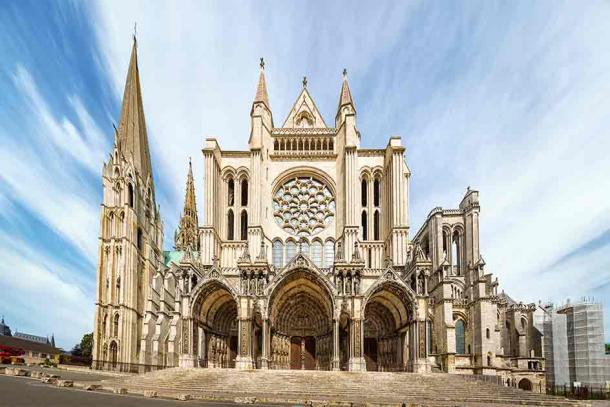
Exterior of Chartres Cathedral in France. (Valerie2000 / Adobe Stock)
Chartres Cathedral is a testament to the determination and will of mankind, crafted by people with a shared belief in an almighty God who they sought to rival through their command of stone, marble, iron, lead, wood and glass. People strain their necks looking at the cathedral, but the real marvel can be found by looking down at the floor.
Here lies the renowned labyrinth of Chartres, a circular, geometric stone construction featuring a single, yet complex, sinuous path which leads to the center. Measuring some 13 by 13 meters (42.65 by 42.65 ft) across, this labyrinth is laid out across the entire nave of the cathedral, filling the space completely, while eleven concentric circuits wind their way to the center of the maze. If you visit the cathedral on a Friday, the chairs are removed, and visitors can see the labyrinth in all its glory and walk its path.
It has been said that the labyrinth at Chartres was seen as an alternative to the journey to Jerusalem, a version of the pilgrimage for those who could not afford the real trip, or who were too frail for a journey to the Holy Land. For this reason, the labyrinth came to be known as the Chemin de Jerusalem, the Jerusalem Road.
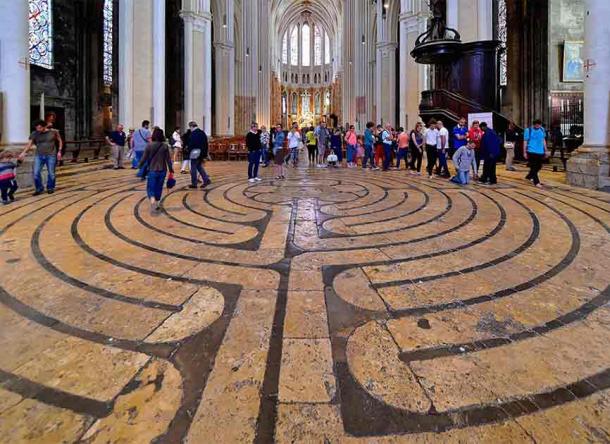
The labyrinth on the floor of the center of the nave at Chartres Cathedral, known also as the Cathédrale Notre-Dame de Chartres, in Chartres, France. (Patrick / CC BY-SA 2.0)
However, when we looked at this labyrinth from the air, we discovered a very clearly defined geometry. The maze is divided into two halves. Each half has what appears to be three upward-reaching arms on each side of the small circle set at the heart. When you look at the Cathedral of Chartres, you look at two mirrored, 7-arm Menorahs, the small circle at its heart being the shared central candle.
It is reminiscent of the Jewish Menorah, as is displayed on the Ark of Titus in Rome, depicting the spoils of the sack of Jerusalem carried through the streets of the city in the year 70 AD. The Menorah was the seven-branched lampstand, made by Moses to God’s own specifications from a single block of gold as specified in the biblical book of Exodus. It is one of the world’s most sacred objects and it has been assumed lost since the 5th century AD.
The discovery got even more interesting when we found out that Chartres doesn’t stand on its own. We knew of another cathedral with a labyrinth in France, in Amiens, and we decided to check it out. Despite is colossal size (it is the largest in France), it manages to possess a subtle and delicate nature, to do with the 3:1 ratio used in its built. It is only 15 meters (49.2 ft) wide, while its ceilings are an astonishing 45 meters (147.64 ft) high.
We found and walked the labyrinth of Amiens. It was about the same size as the labyrinth in Chartres, maybe slightly smaller. It also appeared to follow the exact same path, though it is more octagonal than round. Most importantly we noticed that here too, we were looking at two mirrored Menorahs staring up at us from the floor.
Another feature in the cathedral of Amiens caught our attention: a huge stained glass rose window over the north portal featured a large, upside-down five-pointed pentagram star. Was this the symbol the Knights of the Star had to follow? And if so, where was its mirrored counterpart from King John II’s emblem? We would soon find the answer.
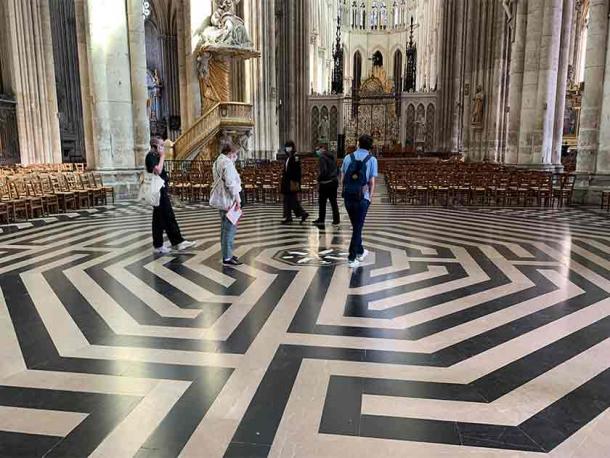
The labyrinth of Amiens, in the center of the floor of the nave at Amiens Cathedral in France. (Chabe01 / CC BY-SA 4.0)
The Search for Saint Louis’s Giant Pentagram
We discovered that there are two more cathedrals in France with similar labyrinths built around the same time, between 1218 and 1280: Reims and Sens. We say "similar" because these churches also had labyrinths, in which we recognized two mirrored seven-armed candelabras. Each one was slightly different, but the shapes were unmistakable.
Reims is a sacred place, where 33 kings of France were anointed. One of those kings united the labyrinth cathedrals that we had identified. King Louis IX of France, later canonized to become Saint Louis, married in Sens, was anointed at Reims, consecrated Chartres and presided as a judge over royal disputes at Amiens.
By now we had also discovered that these four labyrinth cathedrals lay on a circle encompassing the entire city of Paris. Moreover, they appeared to be four points of a giant five-pointed pentagram star. After some calculation we decided that the missing fifth point had to be the Rouen Cathedral, another gothic masterpiece from the same period. But much to our disappointment, the famous cathedral of Rouen has or never had a labyrinth, and we couldn’t find any clues to a giant pentagram.
On leaving Rouen, however, we noticed a second gothic church nearby (as it turned out, Rouen boasts three magnificent Gothic churches) and we decided to give it a go. As soon as we entered this church, we knew we had found our fifth point. A giant pentagram rose window was looking down at us, this one in its upright position, the mirror image of the one in Amiens. Its name: the Abbey Church of St. Ouen, the name we knew from the foundation of the Order of the Star.

The labyrinths of Chartres, Amiens, Reims and Sens, hiding the 7-arm Menorah. (Author provided)
While there isn’t a labyrinth at the church of St. Ouen, its early construction was interrupted multiple times and no plans have survived. So, it might well have been the intention to build one here too.
We have therefore found Jean le Bon’s star. It is roughly the size of the Netherlands, 40,000 square kilometers (15,444 sq mi), which is almost unimaginable. Could the French have known this in the 1100s? Did they have the technology to calculate a shape this size?
- Legendary Black Knights: Mysterious Medieval Entities of Neutrality
- The Legendary Origins of the Most Noble Order of the Garter
Louis IX, Saint Louis King of France, the great-great grandfather of Jean le Bon, might have left another big clue for us. At the very heart of this pentagram, he built the magnificent Abbey of Royaumont, which he helped construct with his own hands and where he spent more time than in any other place during his life.
The abbey included a church that had a floorplan like a Menorah with three entrances to a central nave with seven chapels configured in a half circle at its far end. It must have been a sacred space for him as he buried his wife and some of his children here.
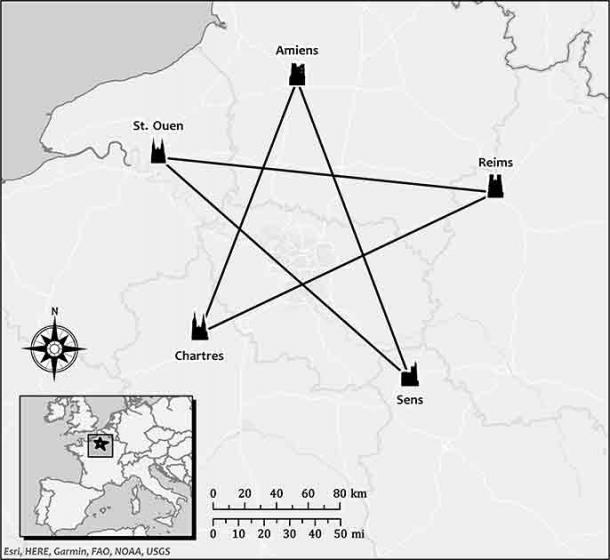
The SACRO pentagram. (Author provided)
The sanctity of this place becomes abundantly clear when you draw the pentagram of labyrinth cathedrals on the map of France with a single line, your pencil never leaving the paper. If you start at Sens, you will pass through Amiens, Chartres, Reims and St. Ouen, and astoundingly, you will have spelled the word SACRO, or “sacred” in Latin. The pentagram and its sacred name couldn’t be clearer. The implications are as significant as the star itself.

The SACRO churches. (Author provided)
The information in this article is only one of dozens of grand reveals in the book “The Jerusalem Files: The Secret Journey of the Menorah to Oak Island” (Watkins / Penguin Random House) by Corjan Mol and Christopher Morford, available from Amazon.
The Jerusalem Files is the true story of two historical researchers on a real-life treasure hunt, tracing the re-discovery and journey of the legendary Jewish Menorah from medieval Jerusalem to present-day North America, providing mind-blowing secret history for everyone who likes real historical mystery detectives.

Top image: Searching for the Knights of the Star and their giant pentagram. Source: Dada635 / Adobe Stock
References
Déprez, E. 1901. “Lettres de Clément VI” in B ibliotheque des Ecoles françaises d’Athènes et de Rome, ser. 3, t. 3 (fasc. 1, 1901), cols 31-7, nos 883-8
Mol, C & Morford, C. 2024. “The Jerusalem Files: The Secret Journey of the Menorah to Oak Island” Watkins / Penguin Random House
Viard, J. & Déprez, E. (eds) 1904. Chronique de Jean le Bel. Paris.
James, J. 1977. “The mystery of the great labyrinth at Chartres” in Studies in Comparative Religion, XI.
















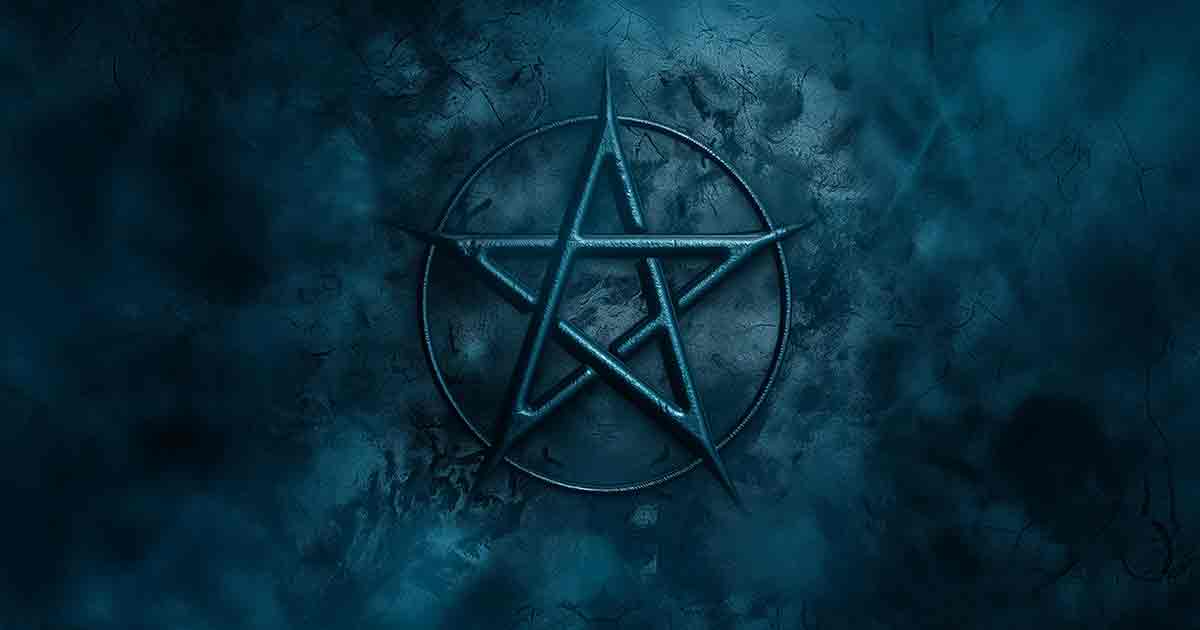

Comments
There's quite a bit of questionable Judaeo-Christianity in this. The menorah is certainly linked to the Old Testament but, equally, it is in more modern times linked to the Occult. The latter links are too obvious to be ignored, once known. Positioning in a cathedral does not necessarily negate this.
To truly follow the symbolism is, ultimately, to end up contemplating the ease at which the Devil hijacks Godly symbolism for ungodly purposes.
Anything less than that is either misleading or being misled.